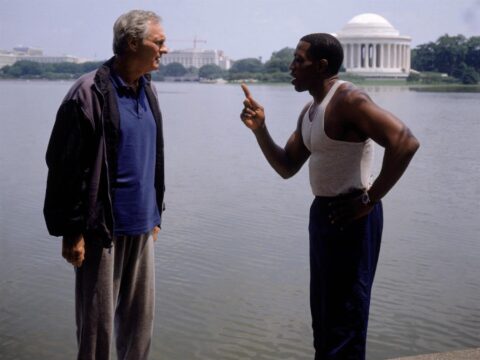In the 90s, Wesley Snipes was easily the coolest American actor (I can’t say “in the world” thanks to Tony Leung). He might have even been an overall cooler African-American actor after Denzel Washington had his career not been derailed by his dodgy accountant (claiming to be a citizen of the world, he didn’t pay his taxes, serving two and a half years in jail between 2010 and 2013). Whether it’s Money Train (Joseph Ruben, 1995), the Blade films, or New Jack City (Mario Van Peebles, 1991), he could play both villains and cops with ease, looking completely unruffled throughout.
In Murder at 1600 (Dwight H. Little, 1997), he is completely unflappable. He’s a DC cop, introduced by defusing a gun-waving suicidal maniac by sympathising with his plight before punching him in the face. He works homicide, asking the question why he was actually present at a negotiating situation as that’s a different job entirely… but we don’t go to movies called Murder at 1600 for logic; just for the opportunity to see Wesley Snipes lord it over his superiors, unfazed and uncompromising in his hunt for justice.
The film relies upon a fundamental misunderstanding of the law: the White House is for some reason its own autonomous legal zone, with secret service agents alone responsible for its law and order. But the President’s National Security advisor — played by Alan Alda with just the perfect hint of menace — nonetheless brings in Harlan Regis (Snipes) to solve the murder of a young secretary in a White House bathroom.
It had the great opportunity to be an Agatha Christie novel set in the Oval Office [1] but Murder at 1600 decides to go the power-fantasy route, Regis the history buff — replete with Civil War-era reconstructions in his flat — knowing all about the secret routes that penetrate into the most secure building in the world. Naturally, given all the CNN coverage of the North Korean[2] hostage situation, we know that geopolitics are never far away either, intersecting in a big-old, heavily dramatised shootout within the palatial grounds.
All the while, Wesley Snipes’ character, surviving assassination attempts and directly implicating the most powerful men in the world, seems totally unbothered by the gravity of his task. He’s one very cool guy, flexing his chill to elevate this generic actioner into a cult work of art. At the time, there was nobody else quite like him.
[1] They couldn’t use the set of Dave (Ivan Reitman, 1993) as it was being used by Absolute Power (Clint Eastwood, 1997) so they built a new one in Toronto.
[2] This was the post-Cold War era where the North Koreans were the new big bad (also see Lee Tamahori’s Die Another Day, 2002) before, ever so briefly, the Chinese (also Wesley Snipes in Christian Duguay’s The Art of War, 2000), the Serbians, the Albanians and then, of course, back to the Russians again.
Redmond is the editor-in-chief of Journey Into Cinema.
